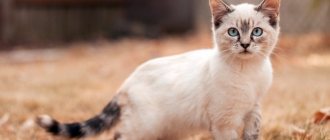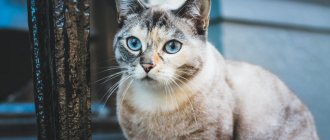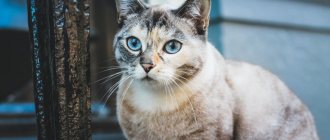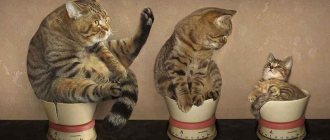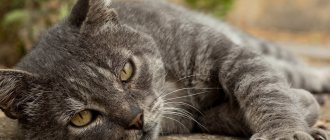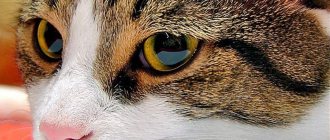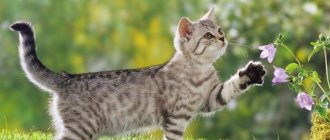Age ratio of kittens up to 12 months
Kittens grow up very quickly.
The most crucial moment occurs at the age of 1-3 months. The kitten adapts to the environment and switches from milk feeding to regular food. From the 4th month to a year, a more stable period. The baby grows, gains weight, discovers the world and puberty occurs. It is difficult to find a specific figure to estimate how many years one month of a kitten’s life will be. Our table allows you to most accurately convert the age of a kitten into human years, taking into account the physiology of development.
| Kitten age | Person's age |
| 1 month | 1.5 years |
| 2 months | 2 years |
| 3 months | 3.5 years |
| 4 months | 5 years |
| 5 months | 6 years |
| 6 months | 7 years |
| 7 months | 9 years |
| 8 months | 10 years |
| 9 months | 11 years |
| 10 months | 12 years |
| 11 months | 14 years |
| 12 months | 16 years |
Childhood (3-4 – 6 months)
A kitten, like a child, actively explores the world and reaches out to its elders (keep in mind that the owner is like a parent for a kitten). Physically, he is growing very quickly, and his irrepressible energy and thirst to explore everything around him require active action. On the one hand, this is a very interesting period for observing a kitten - every day will bring something new. On the other hand, it’s not for nothing that they say that disadvantages are the other side of advantages (as well as vice versa). All this is very good if you or someone in your family are willing to devote a lot of time to the kitten (at least several hours a day): for play, for feeding 6-7 times a day, for frequent visits to the veterinarian (like children, kittens often get sick). You need to be prepared for sleepless nights (however, active games during the day will allow you to sleep better), for overturned things (and, if you are careless, broken), and for the fact that the kitten will require a lot of attention. If you are not ready for this, if you don’t have time for this, then you yourself will miss such an interesting stage in your pet’s life, and you will make him unhappy, perhaps even jeopardizing his health. Or the kitten will simply find something to do alone, and you will be angry about the disorder in the apartment and, in the worst case, decide to part with it.
To avoid all this, if you have a shortage of free time, we recommend that you take an adult pet - it is calmer and more independent and can tolerate loneliness more easily.
Read more: Adopting an adult cat is not a problem!
Cat to human age ratio
There are no significant developmental leaps in growing and adult animals. This makes it easier to correlate the age of a cat and a person.
In this table we have shown what one year of life of a cat or male cat is equal to at the stages of adolescence, youth, maturity and old age per human age.
| Age of the cat | Person's age |
| 1 year | 18 years |
| 2 years | 20 years |
| 3 years | 25 years |
| 4 years | 30 years |
| 5 years | 35 years |
| 6 years | 40 years |
| 7 years | 45 years |
| 8 years | 50 years |
| 9 years | 55 years |
| 10 years | 60 years |
| 11 years | 64 years old |
| 12 years | 68 years old |
| 13 years | 72 years old |
| 14 years | 76 years old |
| 15 years | 80 years old |
| 16 years | 84 years old |
| 17 years | 88 years old |
| 18 years | 92 years old |
| 19 years | 96 years old |
| 20 years | 100 years |
Maturity (10-15 years)
A cat at this time can be compared to a person from 40 to 60 years old. Both humans and cats need to carefully monitor their health at this time (the owner must do this for the cat). For example, it is worth increasing your visits to the veterinarian to twice a year. But with proper care, she will still be healthy and happy with life. Like people, cats become more inclined to calmness and tranquility, and will often prefer the gentle purring of their owners. But from time to time they won’t mind playing.
Life stages of cats
Childhood
Childhood is the most important stage in a pet's life. This period begins with the birth of the kitten and lasts for the first 6 months. At this time, the kitten is growing rapidly and adapting to the world around it. The baby develops immunity and character. By human standards, this is the age from birth to 6-8 years.
Youth
At the age of 6 months, the kitten looks much more like an adult animal, but still remains a child. At this age, he is actively developing, begins to learn to hunt and tries to interact with his brothers not only at the level of play, but also learns to defend his position.
At the age of 8-10 months, puberty occurs. It proceeds approximately the same as in adolescents. The hormonal system works as in an adult organism, which causes estrus in cats, and stimulates cats to mark their territory. At this time, it is still too early to have offspring; the genital organs continue to develop until physiological maturity, at the age of 10–16 months. In humans, this period begins at 7-8 years and lasts until 18-20 years.
Youth
Cats that have reached physiological maturity are considered young. This is the age from 2-3 years to 5 years. During this period, pets are not yet very experienced, but they are active and inquisitive, full of energy and strength. Youth corresponds to 20-35 human years.
Maturity
From the age of 6, cats enter a state of maturity, which lasts until 9-10 years. At our age this corresponds to 55-60 years. Pets of this age group are smart and calmer in nature than the younger generation. If in adolescence and youth a pet can be taught new behavior, then by maturity the skills and reflexes are firmly fixed in the animal’s mind.
Average lifespan of cats
Proper care of a pet and proper nutrition can provide the animal with many years of life, up to 15 years, or even more. Some negative factors associated with poor-quality nutrition, as well as a poor diet, constant movements, which provoke stressful situations, constant hypothermia, which is associated with various diseases, as well as constant confrontation between individuals, as a result of which animals suffer injuries of varying severity.
Interesting fact! The oldest cat in the world was officially recorded as 38 years old. By human standards, this is approximately 145 years.
The lifespan of cats is influenced by the following factors:
- Features of the breed . As a rule, artificially bred cat breeds live longer compared to ordinary cats. The thing is that individuals with good heredity always take part in crossing.
- Sexual activity . Animals that do not have the opportunity to reproduce regularly suffer constantly from high levels of hormones. Therefore, it is necessary to promptly castrate or sterilize your pet.
- Behavior and lifestyle . Individuals who lead an active, mobile lifestyle live significantly longer than sedentary individuals.
- Stressful situations . When the owners of an animal exert psychological pressure on it or physically punish it, the animal can develop severe neurosis.
- Diet . A diet poor in nutritional components has a negative impact on the health of the animal, which is directly related to its life expectancy. No less dangerous may be a diet that includes high-calorie foods that are contraindicated for consumption by pets.
For timely detection of health problems, it is important to regularly visit a veterinarian. A specialist is able to identify problems associated with caring for or keeping an animal at home at an early stage.
Age of the cat by human standards
How to prolong a pet's life?
Be attentive to your pet: learn to recognize signals indicating that the cat is sick. Our domestic carnivores are good at hiding pain, so your observation and discipline can prolong the animal's life.
Proper, species-specific nutrition will help prolong your pet’s life. The sooner you start feeding your domestic predator the way nature intended, the higher the chance of avoiding serious illnesses in old age. SUPERPET is a species-typical BARF food that contains everything necessary for the development and maintenance of cat health. This is a raw diet for daily feeding.
By keeping an eye on your pet's health and wrapping it in care and affection, you can celebrate your cat's “centenary” anniversary.
What affects a pet's lifespan?
Basically, cats live 14 years, but sometimes it happens that your pet leaves you too early, or, on the contrary, becomes a long-liver. The lifespan of cats depends on several factors, namely:
- From the breed. It has been proven that outbred cats and cats of “natural” breeds live much longer than cats of unusual and exotic breeds.
- From the floor. It has been proven that cats live several years longer than males.
- From lifestyle. A pet that eats properly and lives in good conditions lives longer than animals that live in the yard or on the street.
The lifespan of a four-legged pet depends only on the efforts of the owner. Therefore, if you want to “extend” your pet’s life, then take care of it and look after it properly. By the way, the “oldest” cat in the world is considered to be a cat that lived to be 24 years old.
The importance of determining age
Age becomes an issue before you even bring your pet home. When this happens, one of the first decisions you will make. This can mean the difference between a cat that handles the transition well and a cat that is nervous due to behavior problems. The next step is to have your pet spayed or neutered. This may vary depending on the development of the cat breed.
poroda-koshek.com
Another important decision involves your pet's diet. Kittens and adult cats have different nutritional needs. For example, a younger pet should receive more protein, calcium and other nutrients to support its development. Likewise, older pets have different requirements. All animals, including humans, slow down with age. This means dietary changes.
How to find out how old a cat is? (option one)
Many people believe that converting cat years to human age is very easy. You just need to equate one year of a cat to seven years of human life. It would seem that everything is as simple as shelling pears, but if you think about it, everything is not so simple.
- At the age of one year, the cat is equivalent to a seven-year-old child.
- At the age of two, the cat turns into a fourteen-year-old teenager.
- And at the age of 12 years, the pet is already a long-liver, because by human standards, he is already 96 years old.
However, there are also cats that live up to fifteen and twenty years, right? Then the years of cats become unrealistic by human standards.
That is why this method of calculation is not entirely correct.
Determining the number of years lived
It is difficult for an inexperienced owner to determine the age of a cat without the help of a specialist. An experienced breeder is able to accurately indicate the age of his pet, but it would be best to show the animal to a veterinarian. The specialist will not only tell you how old the cat is, but will also paint a general picture of her condition. In veterinary practice, there are several criteria for determining the age of animals.
According to the condition of the teeth
Veterinarians can easily determine the amount of time an animal has lived by looking at its teeth. This method is effective for different individuals, from kittens to old people. This fact can be explained by the fact that the schedule for replacing baby teeth with molars is quite strict. The strength of the fangs and their color are the best indicators of not only the health of the pet, but also its maturity.
| Number of years | Condition of the oral cavity |
| 5 weeks | Baby teeth erupting |
| 6 months | Dairy products are completely replaced by permanent indigenous ones. |
| 1 year | The canines should be in the best condition, white and strong |
| 1.5 years | The incisors on the lower jaw begin to wear off |
| 2 years | The enamel becomes yellow in color and traces of deposits appear |
| 4-5 years | The incisors on the lower jaw wear away very noticeably |
| 6 years | Abrasions on the fangs begin to appear, dark spots appear on the enamel |
| 7 years | The surviving incisors are completely worn away. Fangs in poor condition |
| 10 years | Half of the teeth are lost |
| 13-15 years old | Fangs fall out |
Table 1. Age of cats according to dental condition
The influence of time lived on the condition of the oral cavity is very noticeable. Unfortunately, the owner rarely pays attention to this and is in no hurry to change the pet’s diet when necessary. It would be a good idea to make periodic visits to a veterinarian-dentist, who will assess the condition of the oral cavity and tell you how to prevent teeth from wearing out too early.
According to the condition of the coat
The pet's appearance helps determine a cat's age. This method of definition is the most understandable for a non-specialist. However, veterinarians do not consider this method to be unambiguous, because environmental factors and living conditions can affect the condition of the coat and skin. Good care plus a balanced diet allows you to maintain an excellent appearance even in older individuals. There are only generalized signs that help determine the degree of maturity of a pet.
| Number of years | Type of coat |
| 0-1 | Hair is soft and shiny. There are no signs of baldness or tangles |
| 1-7 | A healthy individual has fur in excellent condition: smooth, fluffy, with a good pattern. Gray hair is completely absent |
| 8-15 | The hair is dull and thin. Tangles and bald spots often appear |
We recommend reading: Protection from a dog in the event of an attack: stun gun and other means
Table 2. Age of cats according to coat condition
This method of determination has many disadvantages. Representatives of some breeds have no hair at all or their hair is quite short and coarse. This makes it much more difficult to figure out changes over the years.
What cat breeds live the longest?
Interestingly, research shows that mixed or crossbred cats are more durable than their purebred counterparts. You may ask why is this true?
Perhaps the deciding factor is breeding. If cats are inbred, there is a greater risk that the offspring will inherit an undesirable trait, such as deafness. If both sibling parents have the gene that codes for the disease, the chances of kittens getting a bad copy from both of them are higher. On the other hand, outbred cats that are not related are likely to have healthier babies.
The cat, who is 15 years old, has lived a long life. The fact remains: with proper care and nutrition, some animals can live up to 30 years
Adopt not a kitten, but an adult cat
So it's no surprise that the stereotype of the "old" 10-year-old cat is becoming a thing of the past. People notice that with responsible handling, treatment, and quality nutrition, such cats, and even older ones, will live for many more years. And their calm disposition, independence, wisdom and at the same time affectionate affection for the owner attract many people, especially those who cannot support the kitten’s hyperactivity. Therefore, in “Murkosh” such cats also quickly find an owner.
If you want a calm, independent pet, come to our shelter and take a closer look at them - perhaps you will find exactly the one you were looking for!
